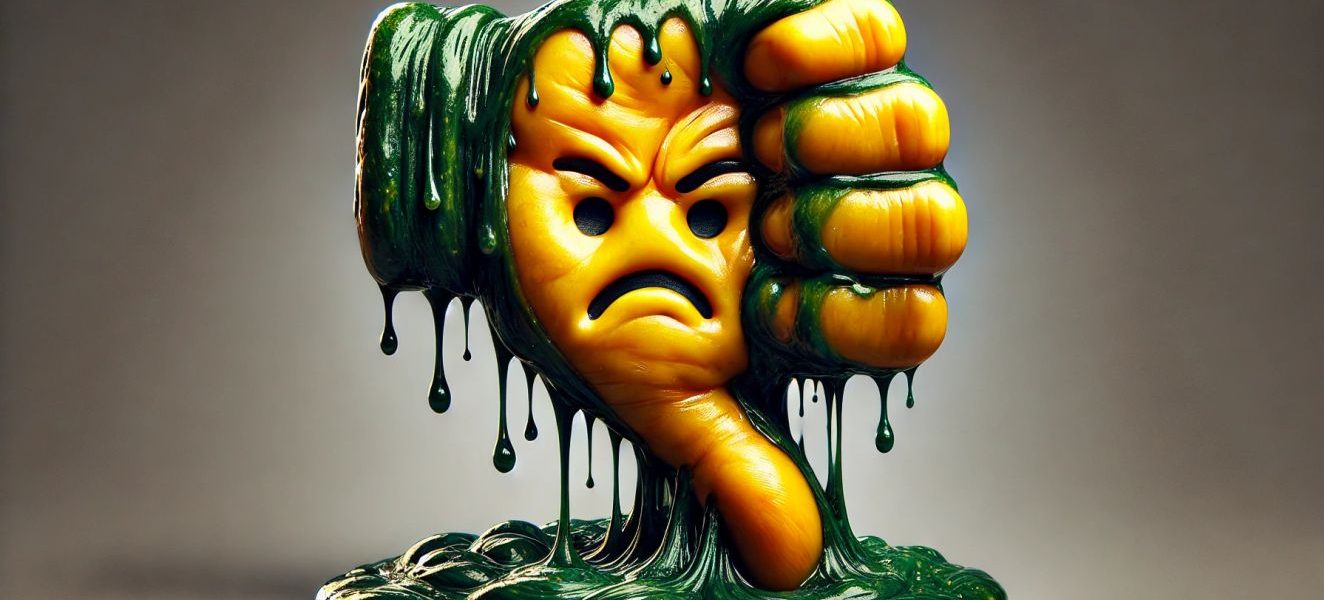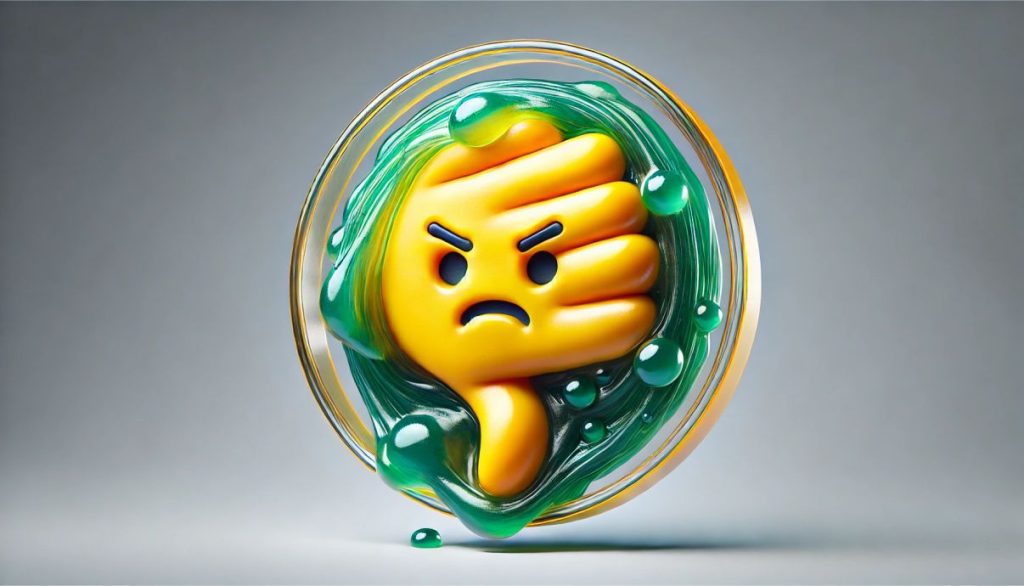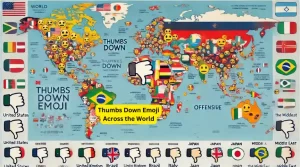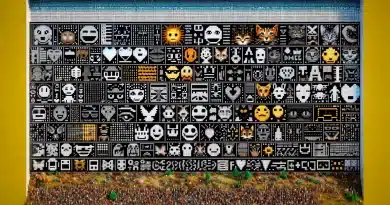Thumbs Down Emoji
Ever wondered how a simple thumbs down emoji can stir up conversations in politics, shape opinions in the arts, influence educational feedback, and even impact the music scene? In our blog post, we break down how this small symbol packs a big punch across different fields. Read on.
The Thumbs Down Emoji: A Digital Dislike
At its core, the thumbs down emoji is a visual representation of disapproval. It’s a quick and easy way to communicate that you don’t agree with something, whether it’s a comment, a post, or even a product, often leading to a negative reaction. The directness is often refreshing, as it allows us to express our opinions without mincing words.But the thumbs down emoji is more than just a simple “no.” It could also be used to convey disappointment, frustration, or even anger. It’s a way to vent our feelings and let others know how we’re feeling.
The History of the Thumbs Down Emoji: From Ancient Times to Unicode
The thumbs down gesture has roots that go way back, long before it became a tiny symbol on our screens. Historically, it’s often associated with ancient Rome, where it was believed to signal disapproval or the call for a gladiator’s defeat in the Colosseum (although, some historians argue this might not be entirely accurate). Over time, this simple gesture evolved to represent rejection, disapproval, and dissatisfaction across various cultures.
From Gesture to Emoji: The Digital Evolution
Fast forward to the digital age, and the thumbs down gesture found a new home on our keyboards and screens. With the rise of emojis in the early 2000s, it was only natural that this classic gesture would be included. The thumbs down emoji (👎) officially became part of the emoji family with the release of Unicode 6.0 in 2010.
Unicode, the organization responsible for maintaining emoji standards, gave the thumbs down emoji a specific point code to ensure it would display correctly across all devices and platforms. Here’s the technical breakdown:
- Emoji Name: Thumbs Down
- Unicode Version: 6.0
- Year Released: 2010
- Point Code: U+1F44E
This means that no matter what device or platform you’re using, when you hit that thumbs down emoji, you’re sending a universally recognized symbol of disapproval.
The Impact of Unicode Standardization
Thanks to Unicode, the thumbs down emoji looks pretty similar whether you’re using an iPhone, an Android device, or even sending it through a messaging app like WhatsApp. However, there are slight variations in design depending on the platform. For example, some versions might look more realistic, while others have a more cartoonish feel. Despite these differences, the core message of disapproval remains consistent.
The inclusion of the thumbs down emoji in Unicode 6.0 was a big step in the digital world, allowing users to communicate dissatisfaction quickly and visually. It’s a prime example of how a simple, ancient gesture has been adapted to fit our modern, digital lives.
Copy and Paste the Thumbs Down Emoji 👎
Want to quickly express your disapproval in a message or post? You can easily copy the thumbs down emoji and paste it wherever you need to convey a strong “no” or show your dissatisfaction. Just follow these simple steps:
- Click the “Copy” button below to copy the thumbs down emoji to your clipboard.
Emoji Copied! 👎 - Go to the place where you want to use the emoji and right-click on the text field.
- Choose “Paste” from the context menu, or simply use the keyboard shortcut Ctrl + V (Windows) or Cmd + V (Mac) to paste the emoji.
And voilà! You’re all set to make your opinions crystal clear in any conversation.
How Thumbs Down is Used in Digital Content
The thumbs down emoji influences how content is perceived and managed. Platforms that allow users to rate or review content often use the emoji to let others know which items are less favored. That user feedback helps users make informed decisions about what to engage with or avoid.
**Example:\ **“Here’s a list of top-rated movies on streaming services. Thumbs down on the ones that didn’t make the cut. 👎”
Use of Thumbs Down on Social Media
On social media platforms, the thumbs down emoji is used for one of the following reasons:
Handling Disapproval and Negative Feedback
On social media platforms, receiving a thumbs down could be a direct form of negative feedback. While it might sting initially, it’s an opportunity for growth and improvement through constructive criticism.
**Example:\ **“Received a lot of thumbs down on my recent video. Time to review the feedback and make some changes. 👎”
Blocked and Rejection
In some cases, the thumbs down emoji is used to indicate that someone’s content or comment is not welcome in online interactions. It’s pretty much a way to block or reject content, signaling that a user prefers not to engage further with what’s being presented.
**Example:\ **“Seems like this post wasn’t well-received — many thumbs down. Maybe it’s time to move on. 👎”
Social Significance Behind the Emoji
The thumbs down emoji isn’t just about saying “no.” It evokes an emotional response and is a powerful symbol that’s shaped by different parts of our lives. Let’s see how it’s used in different areas.
In Politics: A Symbol of Opposition
In the political realm, the thumbs down emoji often represents dissent or disagreement. Politicians, activists, and citizens use it to show their disapproval of policies, proposals, or decisions, reflecting public opinion. That simple gesture is powerful in conveying opposition or frustration without lengthy explanations.
Example: A policy change that many people disagree with might see numerous thumbs down emojis on social media posts or forums discussing the issue.
In Arts: Reactions to Creative Works
In the arts, the thumbs down emoji serves as a straightforward way to express negative feedback about creative works such as films, books, or exhibitions. While it’s a quick way to show discontent, it’s often more helpful when combined with specific comments about what didn’t work, incorporating audience feedback.
Example: A new film release that fails to resonate with audiences might receive a lot of thumbs down emojis from critics and viewers alike, signaling that it didn’t meet expectations.
In Education: Evaluating Feedback
In educational settings, the thumbs down emoji might be used to signify that a particular method, idea, or assignment isn’t effective or well-received. Students and teachers might use it in online discussions or feedback forms to indicate areas needing improvement based on student feedback.
Example: If a new teaching strategy is not well understood by students, the thumbs down emoji might be used in feedback surveys to show that the approach needs to be reconsidered.
In Music: Reception of New Releases
In the music industry, the thumbs down emoji helps fans and critics express their opinions on new songs, albums, or performances. It’s a quick way to show that a piece of music didn’t meet their expectations or preferences, often reflecting fan reactions.
Example: An album drop that doesn’t align with fans’ tastes might see a rise in thumbs down emojis on social media or review platforms, reflecting a less favorable reception.
The thumbs down emoji is a versatile tool for conveying disapproval across different fields. Whether in politics, arts, education, or music, it helps people express their opinions quickly and clearly.
Alternatives and Comparisons
While the thumbs down emoji is a prominent choice for showing disapproval, there are alternative emojis and symbols that convey similar sentiments.
For instance, the face with rolling eyes emoji (🙄) or the cross mark emoji (❌) could also be used to express frustration or rejection. However, the thumbs down emoji remains the most direct and recognizable option.
Cultural Differences: Does the Thumbs Down Emoji Mean the Same Everywhere?
While the thumbs down emoji (👎) is commonly understood as a symbol of disapproval or rejection in many parts of the world, its meaning and impact can vary significantly depending on cultural context. What might be a simple “no” in one country could carry a much stronger or even different connotation elsewhere. Understanding these cultural nuances is crucial when using this emoji in global conversations.
Here’s a table that breaks down how the thumbs down gesture—and by extension, the emoji—is perceived in different countries:
Country/Region |
Cultural Interpretation |
Context & Notes |
|---|---|---|
| United States | Disapproval, disagreement, rejection | Widely used in social media, politics, and everyday communication to express a strong “no” or dissatisfaction. |
| Canada | Similar to the United States | Generally carries the same meaning as in the U.S., though its usage might be less intense in some contexts. |
| United Kingdom | Disapproval, mild offense | Often used similarly to the U.S., but can be considered a bit more aggressive, especially in formal settings. |
| Australia | Disapproval, strong disagreement | Used to express dissatisfaction, though sometimes seen as a bit rude in more conservative circles. |
| Brazil | Strong disapproval, offense | Considered quite rude, especially in formal or professional settings. Use cautiously to avoid offending others. |
| Germany | Disapproval, disagreement | Used similarly to other Western countries, though less commonly seen in professional environments. |
| Italy | Disapproval, but can also be interpreted as rude or dismissive | The gesture (and emoji) might be seen as very dismissive or even offensive, especially when directed at someone. |
| Greece | Rudeness, strong offense | The thumbs down gesture can be seen as extremely rude or insulting. Avoid using it in formal or public contexts. |
| Japan | Disapproval, but with less intensity | While understood as negative, it’s not as strongly used or as offensive as in Western countries. |
| Middle East (various) | Offensive, can be seen as an obscene gesture | The thumbs down can be highly offensive and is often avoided in both personal and professional interactions. |
| China | Disapproval, disagreement | Similar to Western interpretation, though used less frequently in everyday communication. |
| India | Disapproval, but not commonly used | The thumbs down gesture and emoji are understood but not widely used; alternative methods of expressing disapproval are more common. |
Understanding the Differences
As you can see, while the thumbs down emoji is broadly understood as a symbol of disapproval, the strength and appropriateness of its use can vary greatly. In some cultures, it’s a mild and everyday gesture, while in others, it can be seen as rude or even offensive. When communicating across cultures, especially in a professional or formal setting, it’s important to be aware of these differences to avoid unintentional misunderstandings or offense.
In conclusion, while the thumbs down emoji is a handy tool in our digital communication toolkit, it’s essential to consider the cultural context before using it, especially in global conversations. Always keep in mind who your audience is and how they might interpret this seemingly simple gesture.
Conclusion
So, who knew that a little thumbs down emoji could carry so much weight? Whether you’re in politics, the arts, education, or music, this tiny symbol packs a serious punch. It’s not just about saying “no”—it’s about making your feelings known loud and clear. From rejecting a new policy to showing your disapproval of a movie, the thumbs down emoji lets you express your opinion instantly and powerfully.
As we keep relying more on digital communication, emojis like the thumbs down will only grow in importance. It’s not just a quick click; it’s a way to make your voice heard. So, next time you hit that thumbs down, remember—you’re sending a message that really matters. 👎
FAQs About the Thumbs Down Emoji
Yes, using the thumbs down emoji may sometimes come across as blunt or harsh. It’s important to consider the context and the potential impact on the recipient before using it. Providing constructive feedback along with the emoji could make the criticism more balanced and helpful.
The thumbs down emoji can impact content engagement by signaling that users are dissatisfied or uninterested in certain content. In digital communication, this feedback might influence how content creators or businesses adjust their strategies or offerings based on audience reactions
Receiving a thumbs down on your content provides an opportunity for improvement. Review the feedback, understand the reasons behind the negative response, and use it constructively to make necessary changes or enhancements to your content. Engaging with the feedback positively also helps build a better relationship with your audience.
When using the thumbs down emoji, consider pairing it with additional comments or suggestions to provide context for your disapproval. That helps avoid misunderstandings and offers constructive feedback.
The thumbs down emoji may be considered inappropriate in sensitive or personal situations where constructive feedback is more suitable. It’s important to use it with consideration to avoid misunderstandings or negative impacts.








